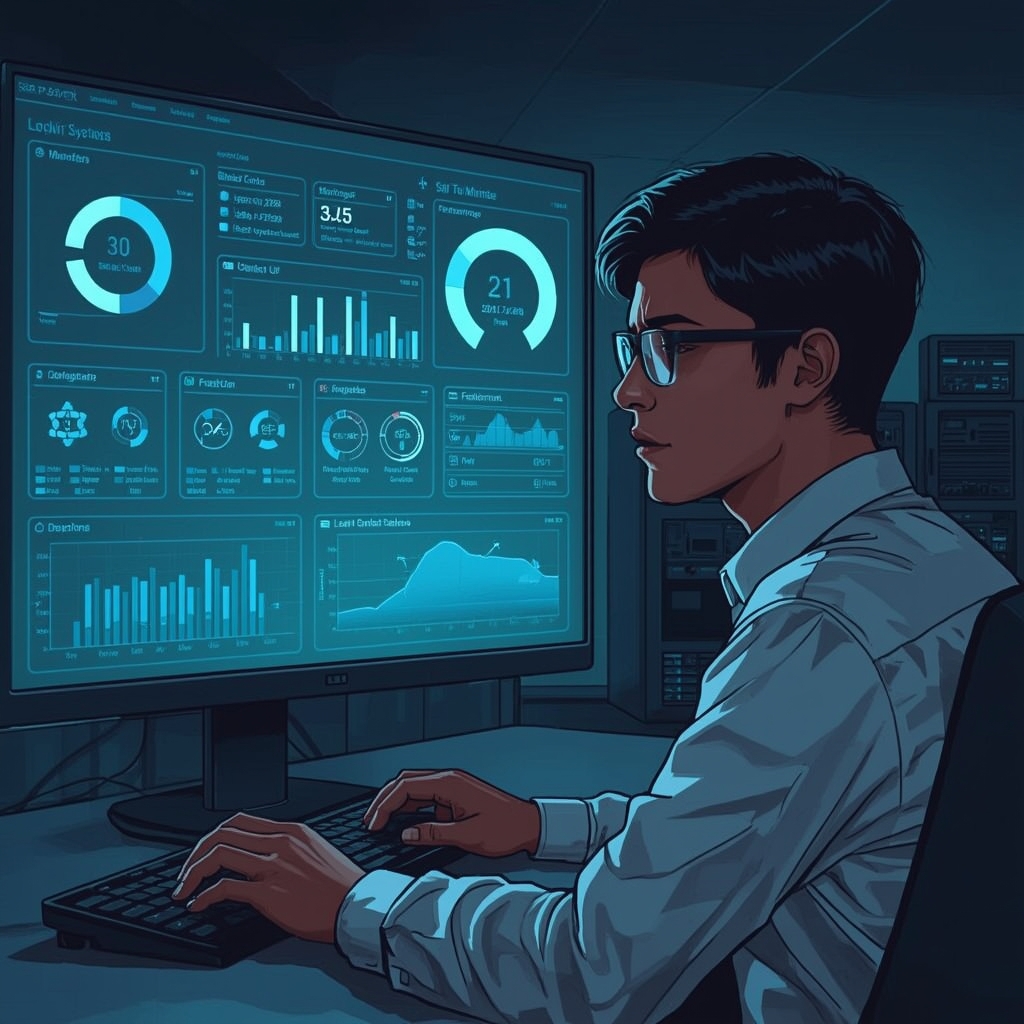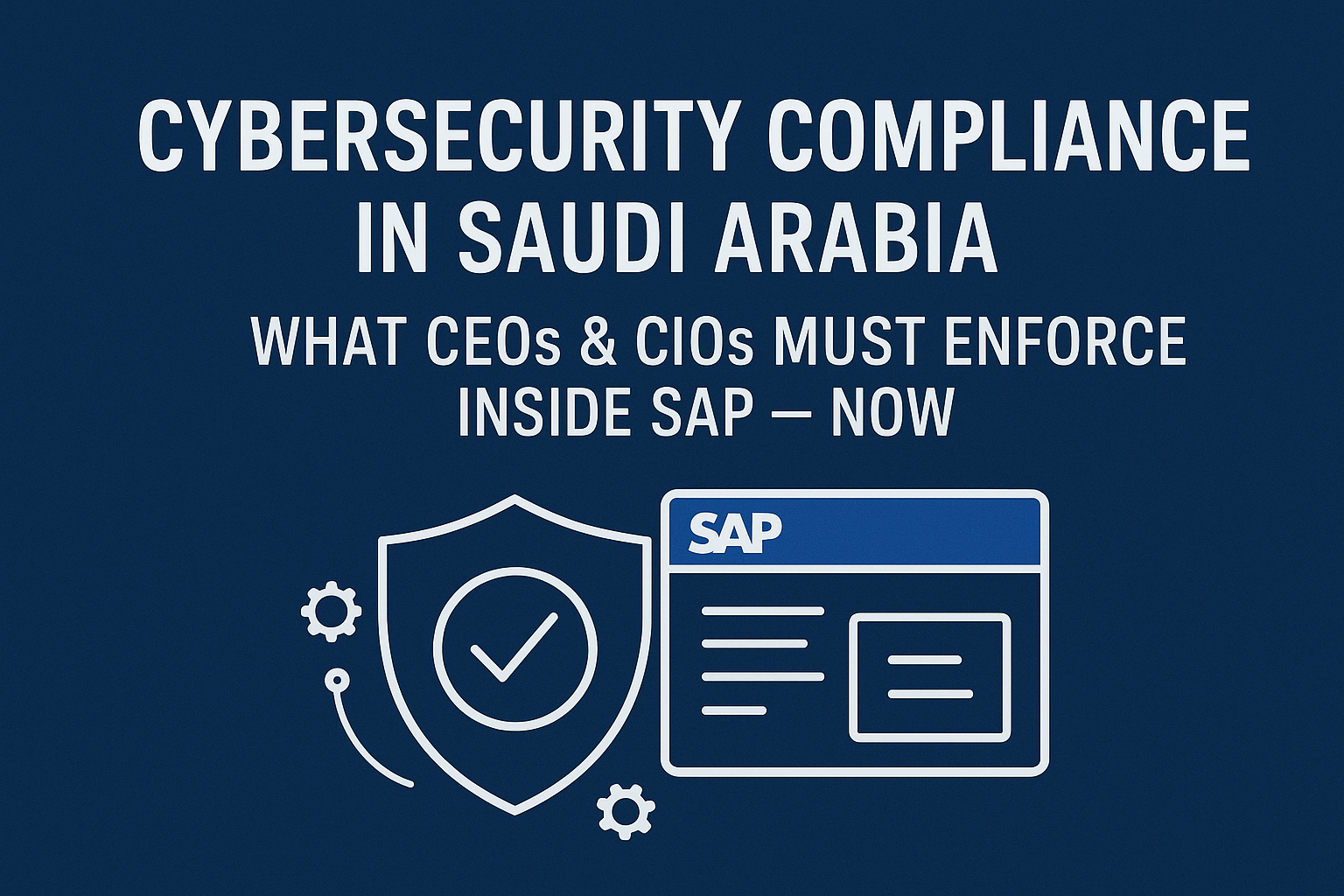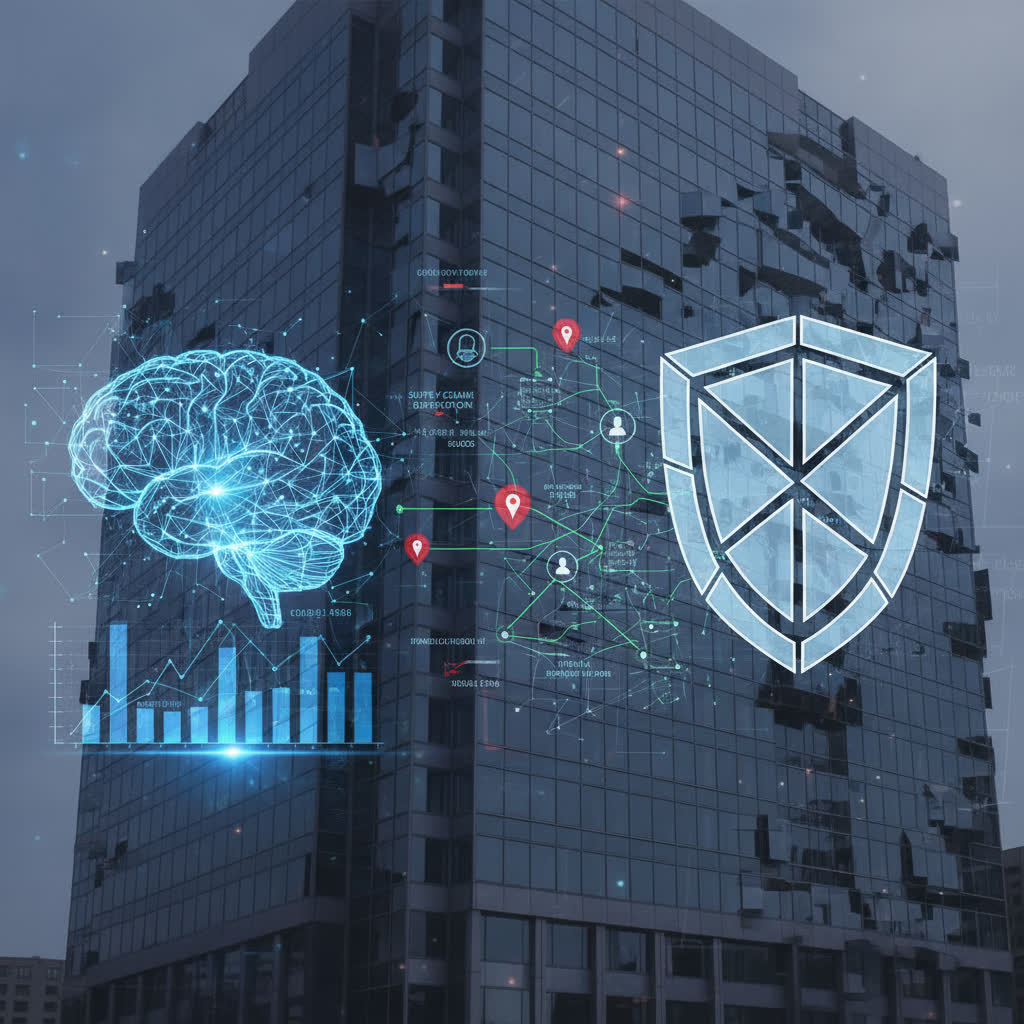Organizations depend heavily on SAP systems for critical business operations and data management. As cyber threats and compliance demands grow, there is a stronger need than ever to keep these systems secure. Real-time monitoring stands as a key strategy to combat risks, detect malicious activity and maintain regulatory compliance in SAP landscapes. Many businesses now recognize that proactive protection is essential but lack actionable information on where to begin. This educational blog aims to provide practical insights into setting up effective real-time monitoring, focusing on IAM (Identity and Access Management), GRC (Governance, Risk and Compliance) solutions and SAP Risk Analysis as a Service.
The Rising Importance of Real-Time SAP Security Monitoring
The significance of SAP in supporting business processes and storing sensitive information makes it a high-priority target for cybercriminals. Attacks on SAP environments can cause business disruption, financial losses or regulatory violations. Real-time monitoring of SAP systems allows prompt identification of unusual or suspicious activity. Unlike traditional periodic audits, real-time monitoring enables security teams to respond immediately and prevent damage. Companies of all sizes in 2025 must prioritize this proactive stance to guard their assets and reputation.
How Threats Emerge in Modern SAP Environments
SAP systems are complex and interconnected with various business modules and external applications. This complexity introduces security challenges. Unauthorized access attempts, privilege misuse or accidental misconfiguration are just some risks that could lead to data leakage. Modern attackers exploit vulnerabilities, phishing techniques and social engineering to bypass standard controls. By understanding the different threat vectors, organizations can create tailored strategies to minimize exposure and respond rapidly to incidents.
The Essential Role of Identity and Access Management (IAM)
IAM (Identity and Access Management) controls play a foundational role in SAP security. They ensure that each user only accesses information required for their role, preventing both intentional and accidental misuse. Implementing and managing IAM processes in real time helps track suspicious logins, privilege escalation and inappropriate data access. This approach also simplifies compliance with data privacy laws and industry standards. Efficient IAM implementation enables precise control, minimizing the risks associated with excessive privileges or outdated user access rights.
Key Features of Effective IAM Implementation
When organizations deploy IAM in SAP environments, key features to focus on include automated provisioning, regular access reviews and robust authentication mechanisms. Automated systems quickly onboard or offboard users, aligning access rights with current organizational roles. Periodic access reviews uncover conflicts and ensure that permissions stay current. Multi-factor authentication adds a vital layer of protection, ensuring that only authorized individuals reach sensitive records. Organizations must also monitor changes in real time, discovering privilege changes or account creations that deviate from policy.
Continuous Monitoring for IAM Effectiveness
Continuous monitoring allows security teams to identify risky patterns instantly. Tools analyze sign-in times, locations and device types, flagging deviations for review. Some systems use machine learning to evaluate normal versus suspicious user behavior, improving detection capabilities. Alerts inform relevant personnel when policy violations occur, enabling rapid investigation before a threat becomes a serious incident. Frequent monitoring leads to improved compliance, reduced audit findings and more efficient remediation of access-related issues.
Leveraging GRC Solutions for Proactive Risk Management
Governance, Risk and Compliance (GRC) solutions are essential for structured and efficient management of SAP risks. Implementing a GRC solution streamlines the process of detecting security threats and ensures organizations fulfill compliance requirements. By automating monitoring policies and workflows, GRC tools help companies centralize incident tracking, documentation and remediation. This centralization minimizes the risk of oversight, ensuring that issues are consistently managed and resolved according to policy and law.
Architecting Real-Time Monitoring With GRC Platforms
Modern GRC platforms integrate with SAP to deliver real-time analytics, alerting and dashboards. These systems provide tailored insights into user activity, role changes and transaction patterns, transforming raw data into actionable intelligence. GRC modules can monitor specific KPIs and regulatory controls, sending alerts when thresholds are breached. Companies gain unparalleled visibility into their SAP security posture, allowing them to act quickly if anomalies are spotted. Integration between GRC and IAM further enhances the precision and coverage of monitoring activities.
Supporting Regulatory Compliance Through GRC
Regulatory frameworks such as GDPR, SOX and ISO 27001 require businesses to safeguard information, manage access and report incidents. A robust GRC solution automates much of the evidence collection and reporting required for audit and compliance. Real-time event logging and reporting simplify internal and external audits. They also reduce the effort needed to demonstrate compliance during regulatory reviews. With enforced workflows and escalation paths, issues receive attention at the right organizational level without unnecessary delay.
Implementing SAP Risk Analysis as a Service
Outsourcing risk analysis as a managed service provides several advantages for organizations seeking enhanced SAP security. With SAP Risk Analysis as a Service, companies receive continuous assessments from specialized teams. These experts identify security gaps, recommend corrective actions and flag threats that might bypass traditional controls. The managed service model allows internal teams to focus on core business priorities while benefiting from high-quality, round-the-clock vigilance over their SAP environments.
Advantages of a Service-Based Approach
This approach provides regular vulnerability scans, configuration checks and transaction monitoring. Service providers deploy cutting-edge analytics and use their specialized knowledge to interpret results. Clients receive detailed reports outlining weaknesses, threat trends and progress over time. Service-based risk analysis covers both operational and regulatory risks, helping businesses take immediate action as required. Scalability means organizations can adapt coverage as their SAP landscape grows or changes.
Integrating Risk Analysis With Other Security Layers
To be most effective, SAP Risk Analysis as a Service should not operate in isolation. Integration with IAM, GRC and broader security frameworks magnifies its value. Consolidated reporting eliminates silos and improves overall decision-making. Frequent updates and real-time alerts support a proactive rather than a reactive security culture. Collaboration between internal IT teams and service providers further accelerates threat identification and remediation efforts.
Designing a Real-Time Monitoring Framework for SAP
Creating a robust real-time monitoring strategy involves several deliberate steps. The first involves mapping out critical business processes and data assets within SAP. This map helps organizations identify high-risk areas that require extra attention. Once priorities are clear, selecting the right combination of IAM, GRC and Risk Analysis tools becomes easier. Each tool should fit naturally into existing workflows and offer integration options for seamless data sharing.
Setting Up Baseline Security Policies
Security policies should clearly define which activities trigger alerts and who receives notifications. Baselines help distinguish normal behavior from suspicious or risky events. Organizations should schedule periodic reviews of these policies to keep them current as business operations change. Documented escalation methods ensure that critical incidents always reach decision-makers in time. A well-crafted baseline enables efficient use of IT resources and reduces alert fatigue among monitoring teams.
Utilizing Automation for Enhanced Response
Real-time monitoring systems increasingly rely on automation to handle large volumes of data. Rules-based engines can respond to certain incidents by deactivating accounts, flagging users for review or starting workflows for password resets. Automation reduces manual workload and improves response times for common threats. At the same time, critical incidents still require human judgment. Blending automation with expert review ensures both speed and accuracy in threat response.
The Human Element: Training and Awareness for SAP Security
Despite advancements in technology, people remain both the strongest asset and weakest link in SAP security. Training employees on best practices, risks and proper use of SAP helps mitigate accidents and prevent insider threats. Regular security awareness programs refresh users on recognizing phishing or suspicious behavior. Encouraging a culture of vigilance ensures even the most sophisticated monitoring systems are supported by people who understand their role in maintaining security.
Building Internal Compliance Champions
Creating a group of internal compliance champions helps promote ongoing adherence to access management rules and GRC protocols. These advocates collaborate with IT and security teams to reinforce good habits and share updates. Peer-to-peer support increases participation and motivation, keeping security top of mind even during routine business activities. Champions also facilitate communication between management and end users, bridging gaps in understanding or expectation.
Encouraging Report-First Mindsets
Employees should feel comfortable reporting security issues or suspected incidents without fear of negative consequences. Clear communication channels and quick feedback reinforce the importance of early detection. The earlier a threat is spotted, the less damaging it becomes. Recognition programs for prompt reporting can incentivize diligence across the workforce.
Evaluating Real-Time Monitoring Solutions for SAP
The variety of SAP security monitoring tools has expanded dramatically in recent years. When selecting monitoring solutions, businesses should consider scalability, ease of integration and support for industry standards. It’s important to align technology investments with long-term objectives, such as compliance, business continuity and cost management. User interfaces should be accessible so that stakeholders from both IT and business departments can interpret findings and make informed decisions.
Vendor Evaluation Criteria
Look for vendors who demonstrate deep industry expertise, offer responsive support and maintain strong customer references. Tools should fit seamlessly with both on-premises and cloud-based SAP deployments. Consider providers who combine technical know-how with strong partnerships across the SAP ecosystem. The solution should support custom reporting and flexible dashboards, allowing organizations to adapt monitoring to their unique risk profile.
Testing and Continuous Improvement
Once implemented, real-time monitoring systems require ongoing validation and tuning. Conduct routine tests to ensure alerts are accurate and actionable. Solicit feedback from users to identify areas for improvement. The security landscape changes rapidly, so flexibility and adaptability are essential for continued success. Businesses should document lessons learned and use them to evolve their processes and technology mix over time.
The Future of SAP Security Monitoring
As artificial intelligence, machine learning and automation continue to develop, these technologies will play a growing role in SAP security. Predictive analytics will identify risks before they become incidents. Adaptive authentication will improve the precision of access controls, reducing the risk of unauthorized activity. Collaboration between business, compliance and IT leaders becomes more important as SAP landscapes grow more complex and interconnected. Ongoing investment in technology and training remains essential for keeping pace with current and emerging threats.
Balancing Investment and Return
Growing regulatory oversight and increased cyber threats require organizations to balance security investments with business objectives. Prioritizing areas where monitoring yields the greatest benefit provides measurable value. Effective risk management, regulatory compliance and business continuity depend on a strategic approach. Organizations that invest in robust real-time monitoring enjoy stronger protection, increased confidence among stakeholders and improved outcomes for every SAP user.
Practical Steps to Implement Advanced SAP Monitoring
Getting started with real-time monitoring in SAP requires a structured plan. First, perform a risk assessment to identify potential vulnerabilities and prioritize high-impact areas. Implement IAM policies to control access and use GRC solutions to automate compliance checks. Consider engaging SAP Risk Analysis as a Service to benefit from external expertise and broader coverage. Regularly update system parameters and review user activity for signs of abnormal behavior. Schedule recurring training for both administrators and end users to reinforce best practices.
Building a Robust Monitoring Roadmap
Begin with pilot projects in areas with the highest risk or most stringent compliance requirements. Gather feedback, measure outcomes and refine your approach. Scale monitoring activities throughout your SAP landscape, ensuring every business process and data store benefits from real-time safeguards. Collaborate across departments to break down silos, share lessons learned and improve outcomes for all users. Over time, your organization will build a security culture rooted in proactive monitoring and continuous improvement.
Cultivating Resilience in SAP Ecosystems
Modern businesses face increasing pressure from external threats and internal complexity. Real-time monitoring acts as a vital defense, enabling organizations to detect and manage threats before they escalate. Combining IAM, GRC solutions and Risk Analysis as a Service creates a layered approach that enhances risk mitigation and streamlines compliance. Commitment to ongoing evaluation, training and technology improvement strengthens the entire SAP ecosystem. By developing a monitoring-first mindset, companies fortify their SAP environments, safeguard their reputation and position themselves for continued growth and success.





